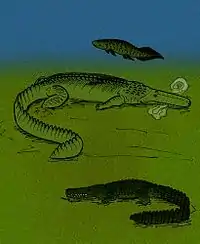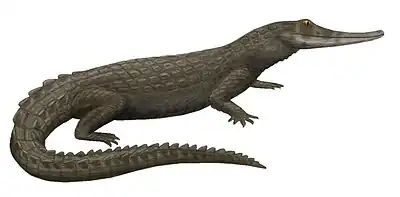Stomatosuchus
Stomatosuchus (type species S. inermis) is an extinct stomatosuchid neosuchian from the Late Cretaceous (Cenomanian) of Egypt. Much of what is known about Stomatosuchus has been inferred from the related genus Laganosuchus.
| Stomatosuchus Temporal range: Late Cretaceous, Cenomanian | |
|---|---|
 | |
| Scientific classification | |
| Domain: | Eukaryota |
| Kingdom: | Animalia |
| Phylum: | Chordata |
| Class: | Reptilia |
| Clade: | Pseudosuchia |
| Clade: | Crocodylomorpha |
| Family: | †Stomatosuchidae |
| Genus: | †Stomatosuchus Stromer, 1925 |
| Type species | |
| †Stomatosuchus inermis Stromer, 1925 | |
Description
It grew to a length of 10 metres (33 ft), and possessed a long, flattened skull with lid-like jaws that were lined with small, conical teeth and the skull reached up to 2 metres (6.6 ft) long. The mandible may have been toothless and perhaps even supported a pelican-like throat pouch.[1] This pouch however could have been used to scoop up fish and sharks much like a modern day pelican, the conical teeth would prevent the prey for escaping. Due to such a bizarre skull structure, much about the diet of S. inermis remains unknown.
The only known specimen of S. inermis consisted of a partial skull and two caudal vertebrae. It was collected in Egypt during 1911 by the German paleontologist Ernst Stromer whilst on an expedition.[2] It was delivered to the Munich Museum, which was later destroyed by an Allied bombing raid in 1944. Currently, only photographs of the specimen remain.
Habitat
It is likely that S. inermis lived in the marshy lowlands of what is now the Eastern Sahara Desert. It may have populated the entirety of Northern Africa but due to the only fossil evidence of the species being destroyed and no other bones having been found since, it is impossible to establish an exact range.
Gallery
 Comparison of Stomatosuchus (center) with Retodus (top) Laganosuchus (bottom)
Comparison of Stomatosuchus (center) with Retodus (top) Laganosuchus (bottom) Skull seen from two angles
Skull seen from two angles Holotype skull
Holotype skull
References
- Naish, D. 2002. Fossils explained 34: Crocodilians. Geology Today 2: 71-77. Archived copy from 24 January 2019.
- Stromer, E. (1925). Ergebnisse der Forschungsreisen Prof. E. Stromers in den Wüsten Ägyptens. II. Wirbeltier-Reste der Baharije-Stufe (unterstes Cenoman). 7. Stomatosuchus inermis Stromer, ein schwach bezahnter Krokodilier und 8. Ein Skelettrest des Pristiden Onchopristis numidus Haug sp. Abhandlungen der Bayerischen Akademie der Wissenschaften, Mathematisch-naturwissenschaftliche Abteilung 30(6): 1–22.


